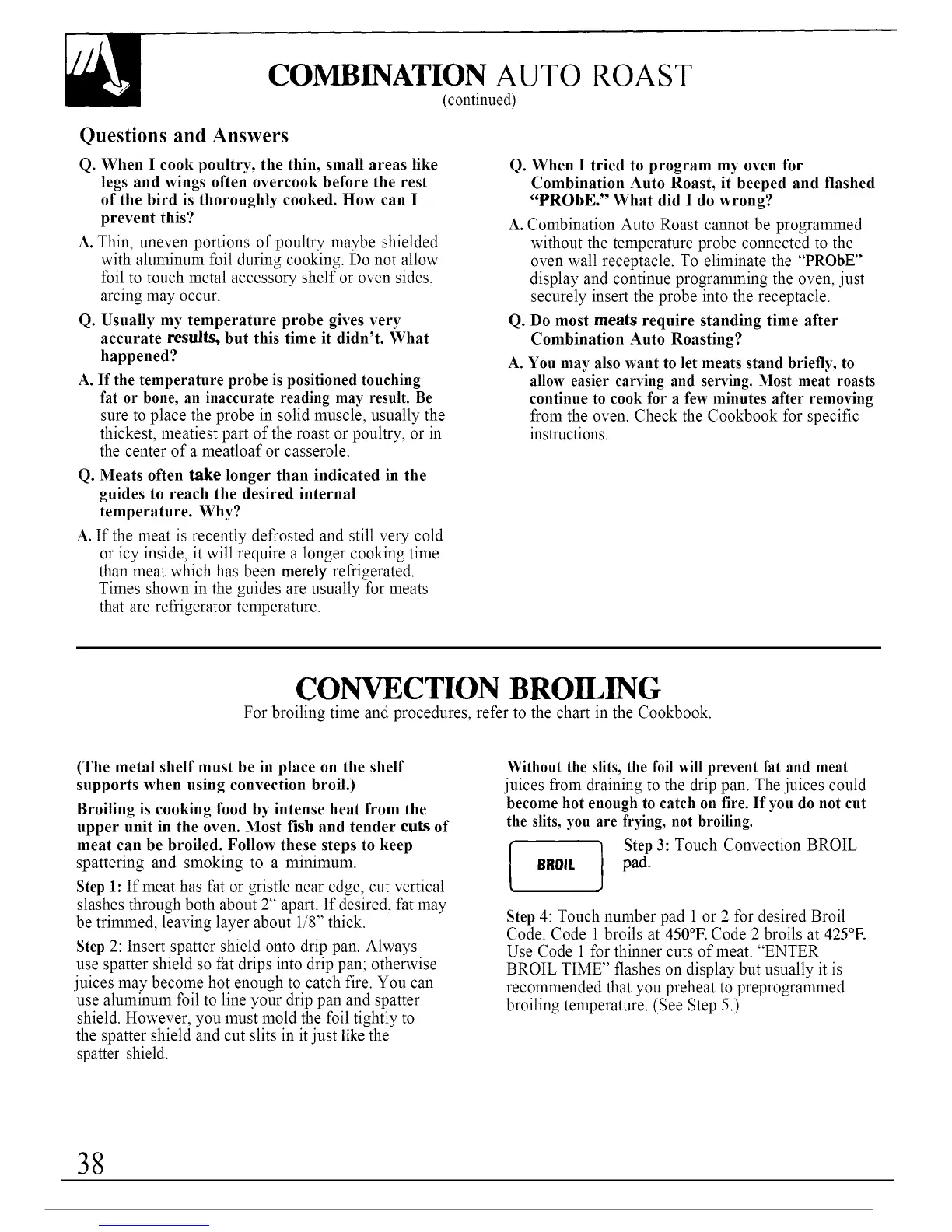COMBINATION AUTO
(continued)
ROAST
Questions and Answers
Q. When I cook poultry, the thin, small areas like
legs and wings often overcook before the rest
of the bird is thoroughly cooked. How can I
prevent this?
A. Thin, uneven portions of poultry maybe shielded
with aluminum foil during cooking. Do not allow
foil to touch metal accessory shelf or oven sides,
arcing may occur.
Q. Usually my temperature probe gives very
accurate results, but this time it didn't. What
happened?
A.
If the temperature probe is positioned touching
fat or bone, an inaccurate reading may result. Be
sure to place the probe in solid muscle, usually the
thickest, meatiest part of the roast or poultry, or in
the center of a meatloaf or casserole.
Q. Meats often take longer than indicated in the
guides to reach the desired internal
temperature. Why?
A. If the meat is recently defrosted and still very cold
or icy inside, it will require a longer cooking time
than meat which has been merely refrigerated.
Times shown in the guides are usually for meats
that are refrigerator temperature.
Q. When I tried to program my oven for
Combination Auto Roast, it beeped and flashed
"PROBE." What did I do wrong?
A. Combination Auto Roast cannot be programmed
without the temperature probe connected to the
oven wall receptacle. To eliminate the "PROBE"
display and continue programming the oven, just
securely insert the probe into the receptacle.
Q. Do most meats require standing time after
Combination Auto Roasting?
A.
You may also want to let meats stand briefly, to
allow easier carving and serving. Most meat roasts
continue to cook for a few minutes after removing
from the oven. Check the Cookbook for specific
instructions.
CONVECTION BROILING
For broiling time and procedures, refer to the chart in the Cookbook.
(The metal shelf must be in place on the shelf
supports when using convection broil.)
Broiling is cooking food by intense heat from the
upper unit in the oven. Most fish and tender cuts of
meat can be broiled. Follow these steps to keep
spattering and smoking to a minimum.
Step 1: If meat has fat or gristle near edge, cut vertical
slashes through both about 2" apart. If desired, fat may
be trimmed, leaving layer about 1/8" thick.
Step 2: Insert spatter shield onto drip pan. Always
use spatter shield so fat drips into drip pan; otherwise
juices may become hot enough to catch fire. You can
use aluminum foil to line your drip pan and spatter
shield. However, you must mold the foil tightly to
the spatter shield and cut slits in it just like the
spatter shield.
Without the slits, the foil will prevent fat and meat
juices from draining to the drip pan. The juices could
become hot enough to catch on fire. If you do not cut
the slits, you are frying, not broiling.
] Step 3: Touch Convection BROIL
BROIL pad.
Step 4: Touch number pad 1 or 2 for desired Broil
Code. Code 1 broils at 450°F. Code 2 broils at 425°F.
Use Code 1 for thinner cuts of meat. "ENTER
BROIL TIME" flashes on display but usually it is
recommended that you preheat to preprogrammed
broiling temperature. (See Step 5.)
38

